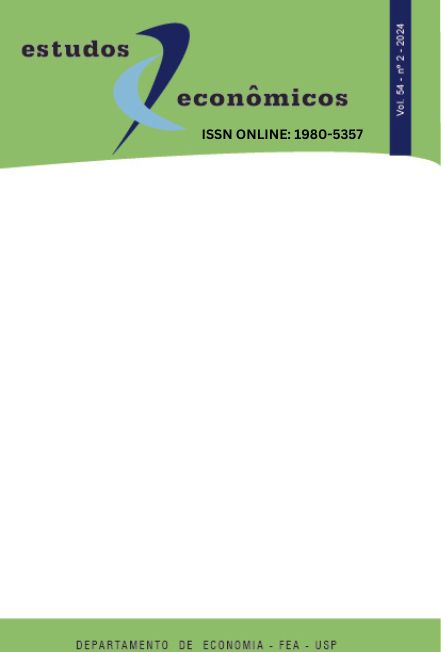Evolution of the annual human capital index for the brazilian economy: 1995-2022
DOI:
https://doi.org/10.1590/1980-53575423fjfaKeywords:
Human capital, Growth accounting, TFPAbstract
In this paper, we construct the Human Capital Index (ICH) for Brazil, covering the period from 1995 to 2022. We used microdata from National Household Sample Surver (PNAD) and PNAD Contínua, both made available by Brazilian Institute of Geography and Statistics (IBGE). We adapted the methodology used by several international organizations, such as the Bureau of Labor Statistics (BLS). The ICH captures structural movements in the quality of the Brazilian workforce, given the wide temporal range of the data, and its derivation is compatible with the usual methodology for decomposing economic growth. We thus used the ICH to adjust the labor factor in the total factor productivity (TFP) calculation. The results show that ICH presented an average annual growth of 2.2% between 1995 and 2022. In addition, the inclusion of the ICH influenced the TFP dynamics, which registered an average annual drop of 0.9% in the analyzed period.
Downloads
References
Aaronson, Daniel e Daniel Sullivan. 2001. “Growth in worker quality.” Economic Perspectives -Federal Reserve Bank of Chicago 25 (4), 53-74.
Abraham, Katharine G. e Justine Mallatt. 2022. “Measuring human capital.” NBER Working Paper 30136, 1-27.
Andolfatto, David. 1996. “Business cycles and labor-market search.” The American Economic Review 86 (1), 112-132.
Barbosa Filho, Fernando H., Samuel Pessôa e Fernando Veloso. 2010. Evolução da produtividade total dos fatores na economia brasileira com ênfase no capital humano – 1992-2007.” Revista Brasileira de Economia 64 (2), 91-113.
Barro, Robert. J. e Jong-Wha Lee. 2013. “A new data set of educational attainment in the world, 1950-2010. Journal of Development Economics 104 (1), 184–98.
Becker, Gary. 1962. “Investment in human capital: a theoretical analysis.” Journal of Political Economy 70 (5), 9-49.
Bosler, Canyon, Mary C. Daly, John G. Fernald e Bart Hobjin. 2016. “The outlook for U.S. labor-quality growth.” NBER Working Paper 22555, 1-69.
Botev, Jarmila, Balázs Égert, Zuzana Smidova e David Turner. 2019. “A new macroeconomic measure of human capital with strong empirical links to productivity.” OECD Working Paper 1575, 1-55.
Bureau of Labor Statistics – BLS. 2023. “Handbook of Methods: Productivity measures - Business sector and major subsectors.” Acesso em 08 de junho de 2023. https://www.bls.gov/opub/hom/msp/concepts.htm.
Deming, David J. 2022. “Four facts about human capital.” NBER Working Paper 30149, 1-28.
De Vries, Klaas, e Abdul Azeez Erumban. 2022. “Total Economy Database: a detailed guide to its sources and methods.” Acesso em 16 de maio de 2023. https://www.conference-board.org/retrievefile.cfm?filename=TED_SMDetailed_
apr2022.pdf&type=subsite.
Feenstra, Robert C., Robert Inklaar e Marcel P. Timmer. 2015. “The next generation of the Penn World Table.” American Economic Review, 105 (10), 3150-82.
Gomes, Victor, Samuel de Abreu Pêssoa e Fernando A. Veloso. 2003. “Evolução da produtividade total dos fatores na economia brasileira: uma análise comparativa.” Pesquisa e Planejamento Econômico 33 (3), 389–434.
Jorgenson, Dale W. e Barbara M. Fraumeni. 1989. “The accumulation of human and nonhuman capital.” In The measurement of saving, investment, and wealth, editado por R. Lipsey e H. Tice, 227-81. Chicago: University of Chicago Press.
Jorgenson, Dale W. e Barbara M. Fraumeni. 1992a. “Investment in education and U.S. economic growth.” Scandinavian Journal of Economics 94 (supplement), S51–S70. Jorgenson, Dale W. e Barbara M. Fraumeni. 1992b. “The output of the education sector.” Em Output measurement in the service sectors, editado por Z. Griliches, 308-38. Chicago: University of Chicago Press.
Liu, Gang, Barbara M. Fraumeni e Shunsuke Managi. 2022. “Human capital growth.” NBER Working Paper 30035, 1-49.
Mincer, Jacob A. 1974. “Schooling, experience and earnings.” Nova York: National Bureau of Economic Research, 1-152.
Organização para Cooperação e Desenvolvimento Econômico – OCDE. 2001. “Measuring productivity: measurement of aggregate and industry-level productivity growth.” Acesso em 23 de maio de 2023. https://www.oecd.org/sdd/productivity-stats/2352458.pdf.
Psacharopoulos, George. 1994. “Returns to investment in education: A global update.” World Development 22(9), 1325–43.
Silva, Cristiano C., José Ronaldo de C. Souza Jr. e Tarsylla da S. de G. Oliveira. 2021. “Índice de qualidade do trabalho e suas implicações sobre a produtividade e a taxa de desocupação.” Carta de Conjuntura IPEA 51(24), 1-26.
Stewart, Jay. 2022. “Why was US labor productivity growth so high during the COVID-19 pandemic? The role of labor composition.” International Productivity Monitor 42 (Spring), 87-103.
Vaz, Bruno Ottoni Eloy e Tiago Cabral Barreira. 2021. “Metodologia de Retropolação da Pesquisa Nacional por Amostra de Domicílios Contínua de 1992 a 2012”. Estudos Econômicos (São Paulo) 51(4), 759-82.
Veloso, Fernando, Fernando de Holanda Barbosa Filho e Paulo Peruchetti. 2022. “Impactos da educação no mercado de trabalho.” Observatório de Produtividade Regis Bonelli. Acesso em 25 de abril de 2023. https://ibre.fgv.br/sites/ibre.fgv.br/files/arquivos/u65/educacao_e_mercado_de_trabalho_03012022_-_final.pdf.
Veloso, Fernando, Silvia Matos e Paulo Peruchetti. 2021. “Nota metodológica dos indicadores anuais de Produtividade Total dos Fatores no Brasil desde a década de 1980.” Nota técnica – Instituto Brasileiro de Economia (FGV-IBRE). Acesso em 27 de julho de 2023. https://ibre.fgv.br/sites/ibre.fgv.br/files/arquivos/u65/nota_de_construcao_
dos_indicadores_-_brasil_anual_ptf_desde_1981_-_final.pdf.
Zoghi, Cindy. 2010. “Measuring labor composition: a comparison of alternate methodologies.” Em Labor in the New Economy, editado por Katharine G. Abraham, James R. Spletzer e Michael Harper, 457-85. Chicago: University of Chicago Press.
Downloads
Published
Issue
Section
License
Copyright (c) 2024 Estudos Econômicos (São Paulo)

This work is licensed under a Creative Commons Attribution 4.0 International License.
By submitting an article, the author authorizes its publication and attests that it has not been submitted to any other journal. The original article is considered final. Articles selected for publication are proofread for grammatical and orthographic errors. The journal does not pay rights for published articles. The Institute of Economic Research from the School of Economics, Business and Accounting of the University of São Paulo (Instituto de Pesquisas Econômicas da Faculdade de Economia, Administração e Contabilidade da Universidade de São Paulo) owns the journal's copyright.
Funding data
-
Coordenação de Aperfeiçoamento de Pessoal de Nível Superior
Grant numbers 001




